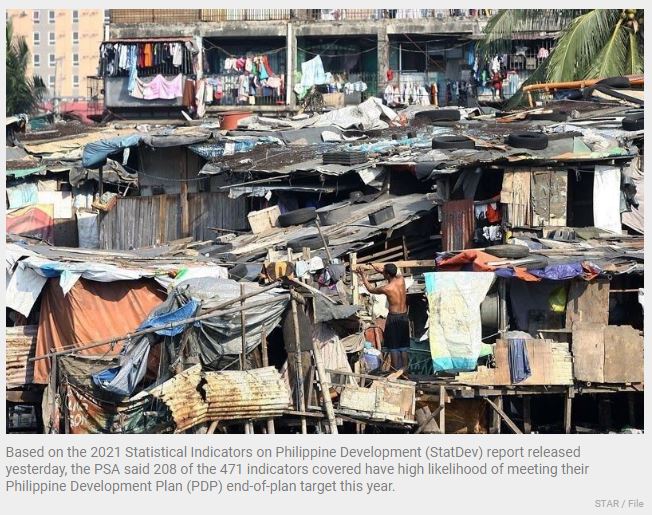PSA: Philippines lags on growth, poverty targets this year
MANILA, Philippines — While the country exceeded the economic development target on shelter and housing, the likelihood of meeting goals in other core indicators such as gross domestic product (GDP) growth rate, poverty incidence as well as in terms of sectors such as social protection and infrastructure are low, a Philippine Statistics Authority (PSA) report showed.
Based on the 2021 Statistical Indicators on Philippine Development (StatDev) report released yesterday, the PSA said 208 of the 471 indicators covered have high likelihood of meeting their Philippine Development Plan (PDP) end-of-plan target this year.
Meanwhile, 60 indicators have medium likelihood and 203 have low likelihood.
StatDev is a measure to monitor economic progress and social change by showing the likelihood of meeting goals set under the PDP.
Among the different sectors, PSA said delivering low-cost and socialized housing had the highest performance, having exceeded their end-of-plan targets.
“The percentage of socialized housing units delivered to socialized housing targets and the percentage of low-cost housing units delivered to low-cost housing targets both exceed their end-of-plan targets of 73 percent and 100 percent, respectively,” PSA said.
In terms of core indicators and headline targets, the StatDev report showed the likelihood of achieving the following targets: the Global Innovation Index goal of placing within the top one-third, unemployment rate of seven to nine percent, youth unemployment rate of 20.5 to 22.5 percent, and underemployment rate in areas outside the National Capital Region at 15.5 to 17.5 percent.
On the other hand, it showed a low likelihood of meeting the following goals: gross national income (GNI) per capita, GDP growth, poverty incidence, subsistence incidence and food inflation.
Last year’s GNI per capita grew at an annual rate of 0.4 percent from a 12.7 percent decrease in 2020, but the figure is still far from the end-of-plan target of five to six percent.
While the country’s GDP rose by 5.7 percent last year from a contraction of 9.5 percent in 2020, PSA said “the
Philippines is still far from hitting its end-of-plan target growth rate of 6.5 percent to 7.5 percent.”
As of the first semester 2021, national poverty incidence or the proportion of poor Filipinos whose per capita income is not sufficient to meet their basic food and non-food needs was at 23.7 percent.
“With an end goal of 15.5 percent to 17.5 percent, the latest report shows low likelihood of attaining the PDP end-of-plan target,” PSA said.
Meanwhile, subsistence incidence or the proportion of Filipinos whose income is not enough to meet even the basic food needs has increased to 9.9 percent in the first semester of 2021 compared to 5.2 percent in 2018.
“This lowers the chance of achieving the planned target of five to seven percent,” PSA said.
As for food inflation, the Philippine government aimed to keep the price of food commodities by two to four percent by the end-of-plan period, but the latest data on food inflation which rose to an annual average of 5.5 percent in 2021, has compromised the PDP end-of-plan target.
The report showed the competitiveness, science and technology and environment sectors have high likelihood of achieving targets.
Sectors with medium chance of attaining targets are macroeconomy; industry and services; overseas Filipino workers; culture and values; governance; agriculture, forestry and fisheries; and human capital development.
Meanwhile, those with low chance of meeting the targets are social protection; infrastructure; demographic dividend; and justice.
Under social protection, PSA said the number of deaths or missing persons due to natural and human-induced disasters in 2021 are from its end-of-plan target of zero.
It also said the number of children benefiting from the Department of Social Welfare and Development’s Supplementary Feeding Program, as well as the number of eligible senior citizens who received social pension both declined, and were below target.
On infrastructure, PSA said the reduced international and domestic air passenger movement last year has intensified the low likelihood of attaining the end-of-plan targets except for Ninoy Aquino International Airport, which posted a high likelihood despite the decline.
It also said barangays with access to material recovery facilities and the number of barangays served by such facilities showed low likelihood of achieving the end-of-plan targets.
In terms of demographic dividend, PSA said the certification rate of technical and vocational education and training for ages 15 to 24 years old increased, but the rate last year is still below the target for this year.
Under the justice sector, PSA said the 6,033 beneficiaries of Victims Compensation Program from 2017 to 2021 is lower than the end-of-plan target of 15,153.
In addition, it cited the percentile rank of the Philippines in the World Justice Project Rule of Law Index, both criminal justice and fundamental rights indicators, showed that the country was way behind the end-of-plan target of 29.
Source: https://www.philstar.com/business/2022/08/04/2200061/psa-philippines-lags-growth-poverty-targets-year


 Thailand
Thailand




